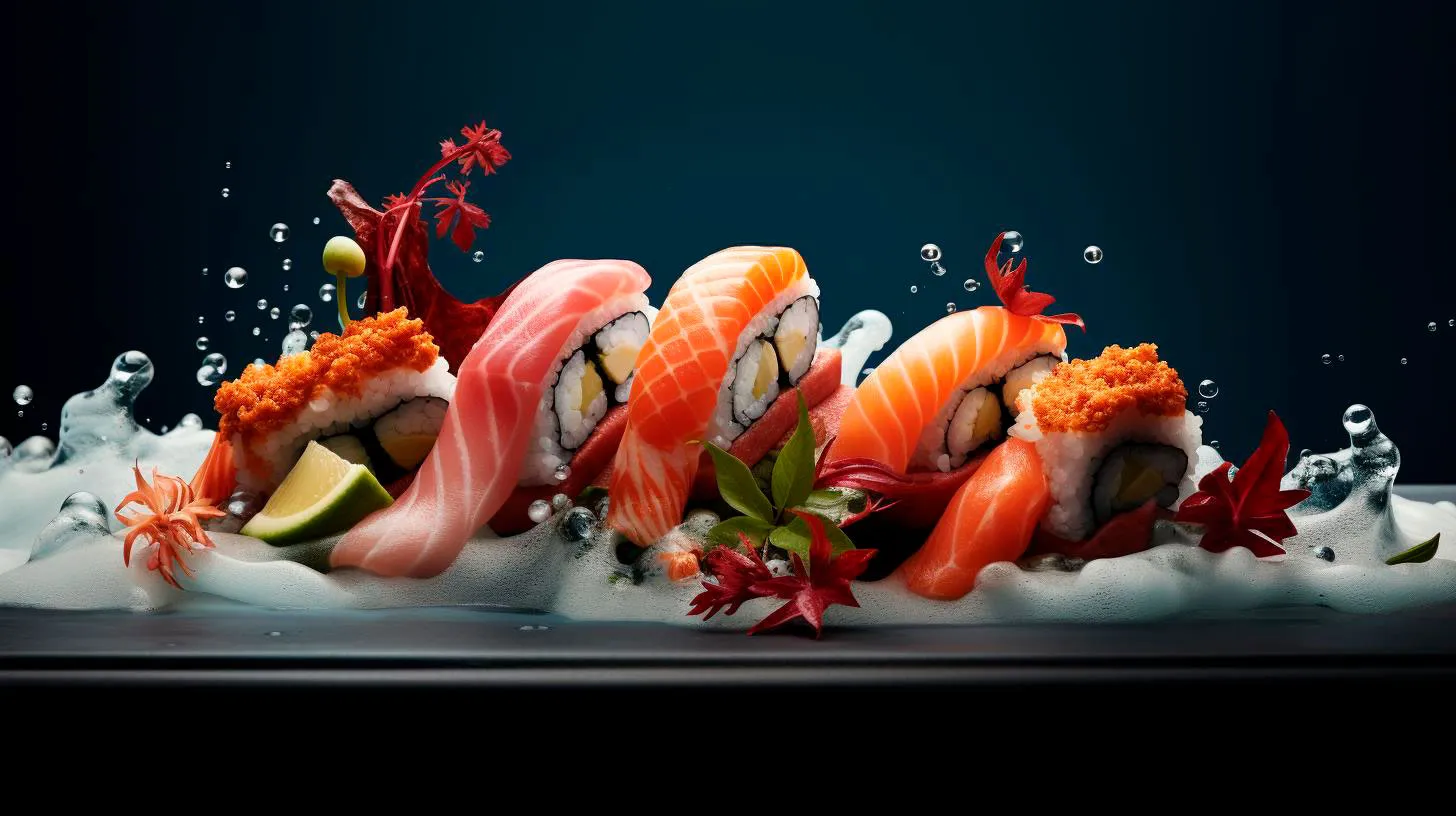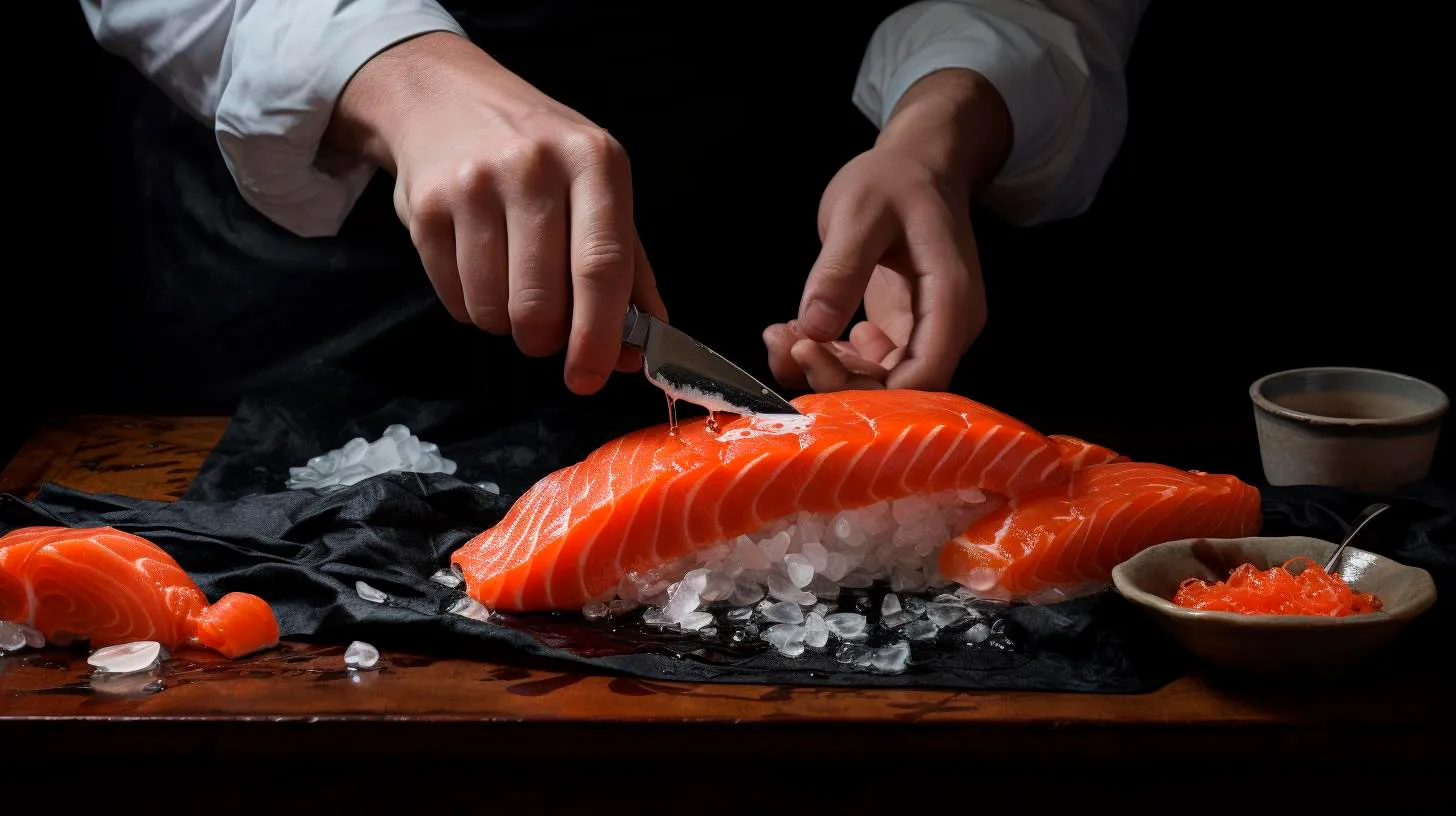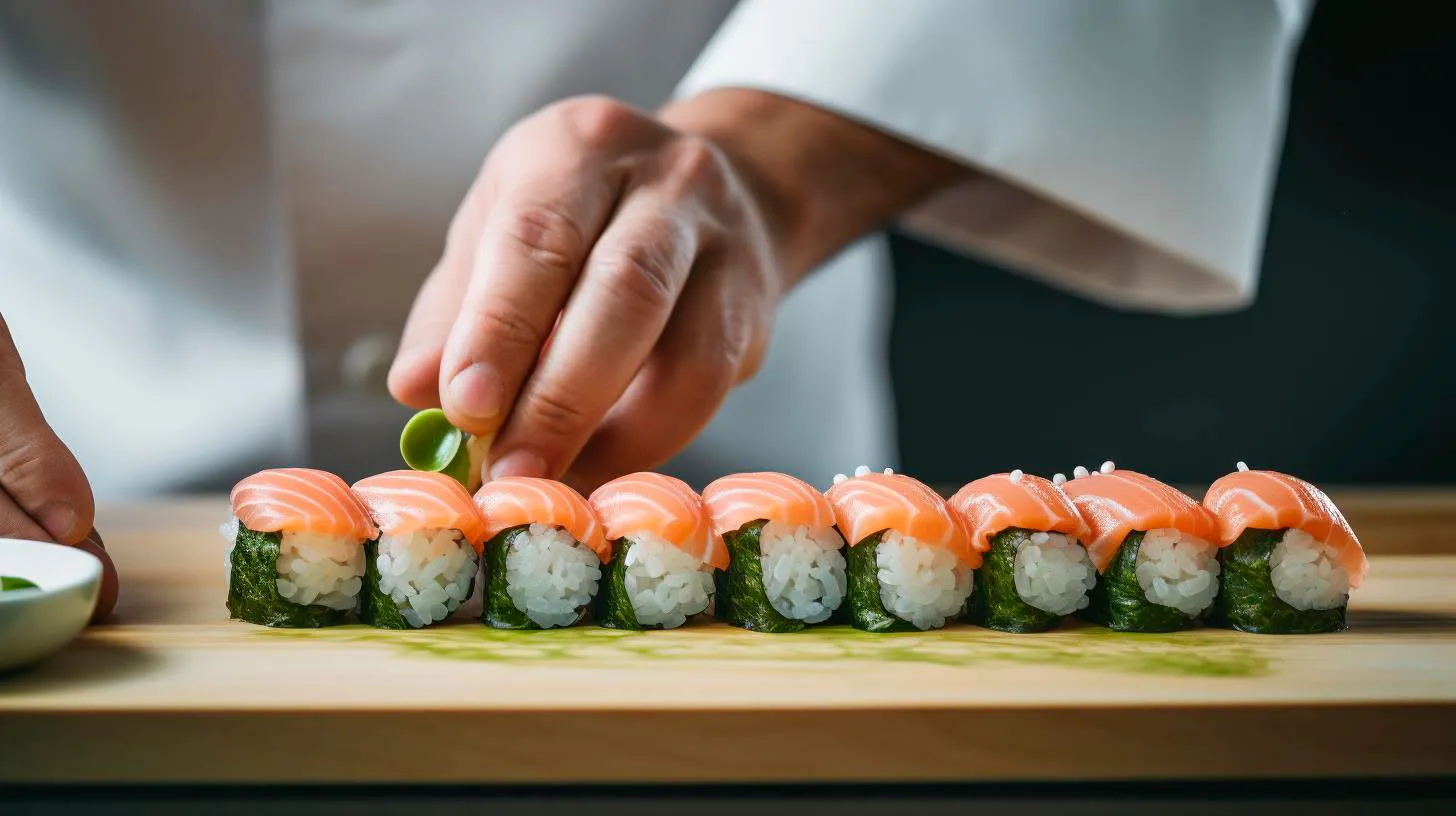Sushi Secrets: Exploring the Authentic Samurai World of Japanese Cuisine
In this article, we will delve into the fascinating world of sushi, revealing its secrets and the authentic samurai legacy it carries. Join us on this culinary journey as we explore the history, types, and key elements that make sushi an extraordinary gastronomic experience.
The Origins of Sushi: A Glimpse into History
Sushi traces its roots back to ancient Japan, where it was initially created as a method of preserving fish. During the 8th century, fish was salted and fermented, and rice was used to speed up the fermentation process. The rice was typically discarded, while the preserved fish was consumed. This early form of sushi, known as narezushi, laid the foundation for the sushi we know today.
Over time, narezushi evolved into a more palatable dish. During the Edo period (1603-1868), the Japanese discovered the art of fermentation, and vinegared rice started replacing the discarded rice. This breakthrough marked the birth of a new sushi form called haya-zushi, which featured the combination of vinegared rice and fresh fish.
However, it wasn’t until the 19th century that sushi took its modern form. Hanaya Yohei, a creative chef from Tokyo, revolutionized sushi by inventing nigiri sushi, where a small mound of vinegared rice is topped with a slice of raw fish. This minimalist style allowed the flavors of the fish to shine and laid the foundation for the sushi we enjoy today.
The Different Types of Sushi: A Culinary Adventure
Sushi comes in various shapes and forms, each with its unique taste and preparation method. Let’s explore the most popular types:
1. Nigiri Sushi
Nigiri sushi is a classic favorite among sushi enthusiasts. It consists of a bite-sized mound of vinegared rice topped with a slice of raw or cooked fish. The combination of perfectly seasoned rice and fresh fish creates a harmonious balance of flavors.
2. Maki Sushi
When you think of sushi rolls, maki sushi comes to mind. It involves rolling vinegared rice, fish, and vegetables tightly in a sheet of seaweed called nori. Maki sushi offers endless possibilities for creative flavor combinations and can be enjoyed in bite-sized portions.
3. Sashimi
Although technically not sushi, sashimi is an essential part of Japanese cuisine. It consists of thinly sliced raw fish or seafood, served elegantly and often garnished with daikon radish or shiso leaves. The delicate flavors and smooth texture of sashimi make it a true indulgence.
The Secrets to Authentic Sushi: Unraveling the Samurai Legacy
Authentic sushi goes beyond the mere combination of rice and fish. It embodies the spirit of the samurai, emphasizing precision, discipline, and respect for nature. Here are the key elements that contribute to the authenticity of sushi:
1. Rice: The Heart of Sushi
High-quality sushi rice is the foundation of a remarkable sushi experience. Short-grain rice, properly cooked and seasoned with vinegar, creates the perfect texture and flavor to complement the fish. The ratio of rice to fish is crucial in achieving a well-balanced sushi bite.
2. Freshness: The Essence of Sushi
The freshness of the fish is paramount for exceptional sushi. In Japanese culinary traditions, fish is often served on the same day it is caught to ensure optimal taste and texture. Sushi chefs meticulously select and handle the fish to preserve its natural flavors.
3. Knife Skills: The Artistry of Sushi
Sushi chefs, known as itamae, undergo years of rigorous training to master the art of knife skills. They use specialized knives to slice fish precisely, highlighting its texture and taste. The precise cuts ensure that the fish melts in your mouth with each bite.
4. Presentation: The Aesthetics of Sushi
Visual appeal is an integral part of sushi. The way sushi is presented showcases the chef’s creativity and attention to detail. From the placement of each ingredient to the use of vibrant garnishes, every element enhances the overall dining experience.
5. Seasonality: Honoring Nature’s Cycles
In line with the Japanese appreciation for nature, seasonal ingredients play a vital role in sushi. Sushi chefs source the freshest seasonal delights, reflecting the changing flavors and abundance offered by each time of the year.
The Key Takeaways: Unveiling the Sushi Secrets
- Sushi originated as a method of fish preservation and evolved into a remarkable culinary art.
- Nigiri sushi, maki sushi, and sashimi are among the most popular types of sushi.
- Sushi showcases the samurai spirit through precision, freshness, knife skills, presentation, and seasonality.
- High-quality rice, fresh fish, and expert knife skills are crucial elements in creating authentic sushi.
- Sushi is not only a delightful gastronomic experience but also an appreciation of Japan’s culture and history.
Embark on a sushi adventure and savor the exquisite flavors that have captivated taste buds for centuries. Whether you are a sushi aficionado or a newcomer, the world of sushi offers an extraordinary journey through the authentic samurai legacy of Japanese cuisine that will leave you longing for more.
The Perfect Pairing: Enhancing the Samurai Experience with Delicious Sushi Creations
In this article, we will explore how the perfect pairing of sushi and samurai enhances your cultural experience, and discover the key takeaways from this beautiful fusion.
The Art of Sushi Making
Let’s start by delving into the remarkable art of sushi making. Sushi is a delightful Japanese dish made from vinegared rice combined with fresh seafood, vegetables, and sometimes even tropical fruits. This culinary craft has been perfected over centuries, blending flavors, textures, and colors into a harmonious presentation that tantalizes all senses.
Key takeaways:
- Sushi is a traditional Japanese dish that combines vinegared rice and various ingredients.
- It is an art form that involves balancing flavors, textures, and presentation.
- There are various types of sushi, including nigiri, maki, and sashimi.
The Samurai and Sushi Connection
The samurai warriors were not only fierce fighters but also patrons of the arts. They sought refinement in all aspects of life, including their meals. Sushi became a favorite delicacy among the samurai, capturing their attention with its elegance and depth of flavors. The connection between the samurai and sushi goes beyond mere enjoyment; it represents the attention to detail, commitment to excellence, and appreciation for simplicity that were cherished values in samurai culture.
Key takeaways:
- Sushi was highly regarded by the samurai warriors for its elegance and flavors.
- The samurai appreciated the values of attention to detail, commitment to excellence, and simplicity.
- Sushi became a symbol of refined taste and cultural sophistication.
The Perfect Pairing
So, what makes sushi the perfect pairing to enhance the samurai experience? It’s the synergy that arises when two distinct elements come together to create something extraordinary. While exploring the world of samurais and their traditions, indulging in a beautifully presented sushi roll can transport you to ancient Japan, where the arts of war and culinary excellence coexisted in perfect harmony.
Key takeaways:
- The combination of sushi and samurai culture creates a unique and immersive experience.
- Both sushi and samurai represent the pursuit of mastery and a dedication to perfection.
- The flavors and presentation of sushi evoke the elegance and refinement cherished by the samurai.
The Advantages of the Pairing
Pairing sushi with the samurai experience offers several advantages for those seeking to delve deeper into the realm of Japanese culture:
- Culinary Appreciation: By indulging in sushi, you can expand your palate and appreciate the artistry of Japanese cuisine. Each bite takes you on a journey of flavors and textures carefully curated by skilled sushi chefs.
- Cultural Immersion: You are not merely enjoying a meal but immersing yourself in centuries-old traditions. Savoring sushi while exploring the samurai history can ignite a deeper understanding and appreciation for Japanese culture.
- Connection to History: The samurai were an integral part of Japanese history. Pairing sushi with their legacy allows you to connect on a profound level with their way of life, their principles, and the influence they had on Japanese society.
The Perfect Pairing: Key Takeaways
As you embark on your samurai and sushi journey, keep these key takeaways in mind:
- The art of sushi making is a culinary craft that involves balancing flavors, textures, and presentation.
- Sushi became a symbol of refined taste and cultural sophistication admired by samurai warriors.
- Pairing sushi with the samurai experience allows for a deeper cultural immersion and connection to Japan’s rich history.
- Savoring sushi enhances your overall understanding and appreciation of Japanese cuisine and traditions.
So, the next time you find yourself enthralled by the allure of samurai legends, take a moment to enrich your experience with the perfect pairing of delicious sushi creations. Immerse yourself in the flavors, and let your taste buds be transported to a time when warriors roamed the ancient lands of Japan.
From the Kitchen to the Battlefield: The Warrior Diet Connection to Samurai Living
This article explores the Warrior Diet and its connection to the disciplined lifestyle of samurai in Japan.
What is the Warrior Diet?
The Warrior Diet is a type of intermittent fasting that follows a specific eating pattern. It was popularized by Ori Hofmekler, a former Israeli soldier and author of “The Warrior Diet: Switch on Your Biological Powerhouse For High Energy, Explosive Strength, and a Leaner, Harder Body.” The diet aims to mimic the eating habits of ancient warriors.
The basic structure of the Warrior Diet involves fasting for 20 hours a day and eating a large meal in the evening, typically within a four-hour window. During the fasting period, small amounts of raw fruits and vegetables are allowed, as well as some protein sources such as hard-boiled eggs or a small serving of cottage cheese. The main meal in the evening consists of whole, unprocessed foods, including a variety of lean proteins, vegetables, and healthy fats.
The Samurai Connection
The Warrior Diet shares similarities with the eating habits of the samurai, the noble warriors of feudal Japan. These ancient warriors followed a strict code of conduct known as Bushido, which emphasized discipline, honor, and self-control. The samurai believed that refining the body and mind through various practices, including diet, was essential for success on the battlefield.
The samurai’s diet, known as “chisanbop,” consisted of simple and unpretentious meals. They consumed a predominantly plant-based diet composed of rice, vegetables, tofu, and fish. This diet provided them with sustainable energy, improved focus, and physical endurance, all essential for their military duties.
Key Takeaways from the Warrior Diet
1. Intermittent Fasting: The Warrior Diet’s intermittent fasting approach helps optimize the body’s natural metabolic processes by cycling between periods of fasting and feasting. This can lead to weight loss, improved insulin sensitivity, and increased energy levels.
2. Increased Mental Clarity: By avoiding constant snacking and eating larger, balanced meals, individuals following the Warrior Diet can experience improved cognitive function and mental clarity. This can positively impact productivity and focus in various areas of life.
3. Enhanced Fat Burning: The Warrior Diet activates the body’s natural fat-burning mechanisms by promoting a state of ketosis during the fasting period. This can be particularly beneficial for those looking to reduce body fat and improve body composition.
4. Increased Discipline: Following the Warrior Diet requires discipline and self-control, similar to the mindset of the samurai. This commitment can extend beyond diet into other areas of life, fostering a sense of resilience and determination.
The Benefits of the Warrior Diet
The Warrior Diet offers several potential benefits beyond physical health. These include:
- Improved self-discipline and willpower
- Enhanced mental clarity and focus
- Weight loss and improved body composition
- Increased energy levels
- Reduced risk of certain chronic diseases
Final Thoughts
The Warrior Diet draws inspiration from the disciplined lifestyle of ancient warriors and provides a structured framework for healthy eating. While it may not be suitable for everyone, individuals looking to optimize their physical and mental performance may find the principles of the Warrior Diet beneficial. Remember, it’s essential to consult with a healthcare professional before making any significant dietary changes.
Unleashing the Power of the Warrior Diet: Energize Your Body and Mind
This revolutionary eating pattern promises to energize both our bodies and minds, allowing us to unlock our full potential. Let’s delve into the intricacies of the Warrior Diet and understand how it can transform your life.
Understanding the Warrior Diet
The Warrior Diet is not just a typical diet; it is more of a lifestyle choice. Inspired by ancient warrior societies, it involves intermittent fasting and carefully chosen foods during the eating window. This eating pattern follows a 20:4 daily cycle, with 20 hours of fasting and a 4-hour eating window. During the fasting period, you can consume small portions of raw fruits, vegetables, and protein-rich foods like boiled eggs or lean meats.
This type of intermittent fasting allows your body to enter a state of ketosis, where it primarily utilizes fats for energy instead of carbohydrates. By doing so, it targets stubborn fat stores, aiding in weight loss and improving overall body composition.
The Benefits of the Warrior Diet
- Improved Energy Levels: By following the Warrior Diet, your body becomes accustomed to utilizing stored fats as an energy source, resulting in sustained energy levels throughout the day.
- Enhanced Mental Clarity: With improved energy levels, your focus and cognitive abilities are sharpened, enabling you to perform better in tasks that require mental acuity.
- Weight Loss and Muscle Preservation: The Warrior Diet helps in shedding excess body fat while preserving muscle mass, aiding in achieving a leaner, more toned physique.
- Reduced Inflammation: By consuming whole, unprocessed foods during the eating window, you provide your body with essential nutrients that combat inflammation, promoting better overall health.
- Improved Insulin Sensitivity: The fasting period helps regulate insulin levels, improving your body’s response to this hormone, and reducing the risk of developing insulin resistance and related conditions.
Key Takeaways
The Warrior Diet offers a unique and effective way to energize your body and mind. By incorporating intermittent fasting into your routine, you can experience a wide range of benefits, including improved energy levels, enhanced mental clarity, and weight loss. Remember these key points:
- Follow a 20:4 fasting and eating window cycle.
- Consume small portions of raw fruits, vegetables, and protein-rich foods during the fasting period.
- Embrace whole, unprocessed foods during the eating window for optimal nutrition.
- Stay consistent with the Warrior Diet to experience its long-term benefits.
Embark on the warrior path and unleash the power of the Warrior Diet to fuel and nourish your body and mind. Experience the transformation that awaits you and take control of your well-being today!



